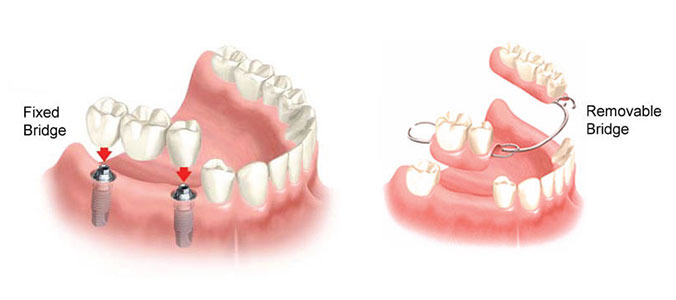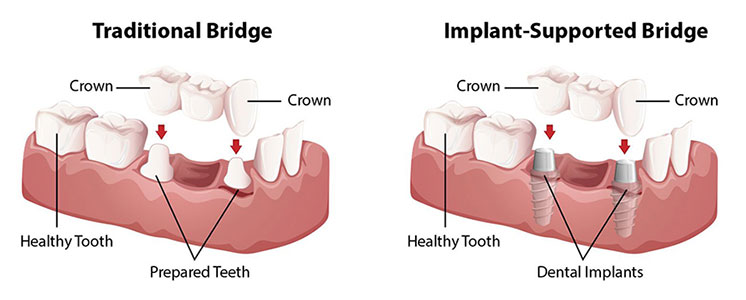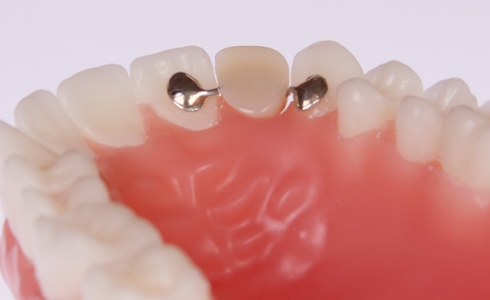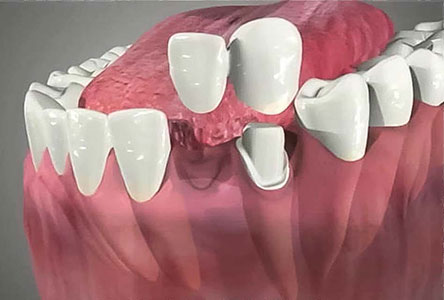Dental bridges are a dental prosthesis which bridges a gap created when a person loses at least one of their teeth.

Dental bridges are cemented in place by attaching to the adjacent teeth. The part of the dental bridge centered over your missing tooth is called the pontic, and the adjacent teeth which it connects to are named the abutments. Cementation of a fixed bridge is to the two teeth on either side of the tooth gap. Bridges can restore a person’s smile, a person’s ability to speak, and also optimize the ability to chew. Also, they can help hold the shape of a person’s face, properly distribute biting force, and help prevent remaining teeth from shifting
The first step in doing a dental bridge is planning. St. Lawrence Dentistry will review all options available to you to fill in any missing gaps in your teeth. Dr. Hawryluk will help you make an informed decision whether or not a dental bridge is right for you. There are a few different types of dental bridges, and they can be reviewed and explained to you. Other options available to fill in missing teeth include dental implants and removable partial dentures. Each of these has advantages and disadvantages.

The most common type of dental bridge is the traditional bridge. This prosthetic is held together by dental crowns on either side of the missing tooth space. The traditional bridge is the most robust and most durable form of dental bridge, and they can be very esthetic. The disadvantage is shaving of the adjacent teeth is needed to make space to place the dental crowns to hold the bridge. If the two adjacent teeth are in pristine condition, then a fixed bridge can be counter-productive because it can be viewed as invasive or destructive to prepare the dental crowns. However, if the adjacent teeth already have dental crowns or could benefit from dental crowns, then a traditional bridge can be an ideal option.

Another type of dental bridge is the Maryland Bridge. This is usually used for front teeth since they don’t have as much pressure applied to them (unlike the back teeth which do most of the chewing). Maryland bridges are cemented in with resin and often have metal or porcelain wings that attach to the adjacent teeth on either side of the gapped area. This type of bridge has the advantage of having less or no preparation (shaving down) of the adjacent teeth. However, Maryland bridges do not have as much retention as a crown retained traditional bridge and can be prone to falling off. This can be frustrating for a patient and if a patient is considering a Maryland bridge they must be fully informed if there is a possibility it could de-bond. This type of bridge is great for temporary solutions such as when a patient is waiting for a tooth socket to heal in preparation for placing an eventual dental implant.

A Cantilever bridge is another type of bridge that is unique in that it attaches to only one tooth on either side of the tooth gap. This type of bridge only involves crowning one tooth (as opposed to two with a traditional bridge). However, there can be severe harmful effects of the cantilever bridge on its abutment tooth. When a bridge is only supported on one side, it can place critical torque on the tooth holding it in, which can lead to premature tooth loss. One scenario where a Cantilever bridge works well is in a situation where a stable dental implant serves as the abutment for the bridge. Dr. Hawryluk will carefully assess your condition to see if this type of bridge is suitable for you.
Dental bridges generally take two appointments to fabricate. The first appointment involves Dr. Hawryluk reshaping the teeth (if needed), and then he will take an impression of the missing tooth and surrounding teeth. We will then send your impression to the ‘Dental Works Laboratory’ in Mississauga. There Teresa, a renowned Certified Dental Technician, will create your bridge. After the lab has perfected your dental bridge, it will be delivered back to St. Lawrence Dentistry to insert. Dr. Hawryluk will ensure the bridge fits as intended, and the aesthetics are excellent. At the insertion of your bridge, we encourage you to bring anyone you like to give their opinion on the aesthetics of the porcelain work.
A properly fitted dental bridge can make a big difference for people with missing teeth on many levels. St.Lawrence Dentistry would like the opportunity to see if this type of treatment is right for you. If you live in the Mississauga, Oakville, or Toronto area and require an excellent dentist, please give us a call.



